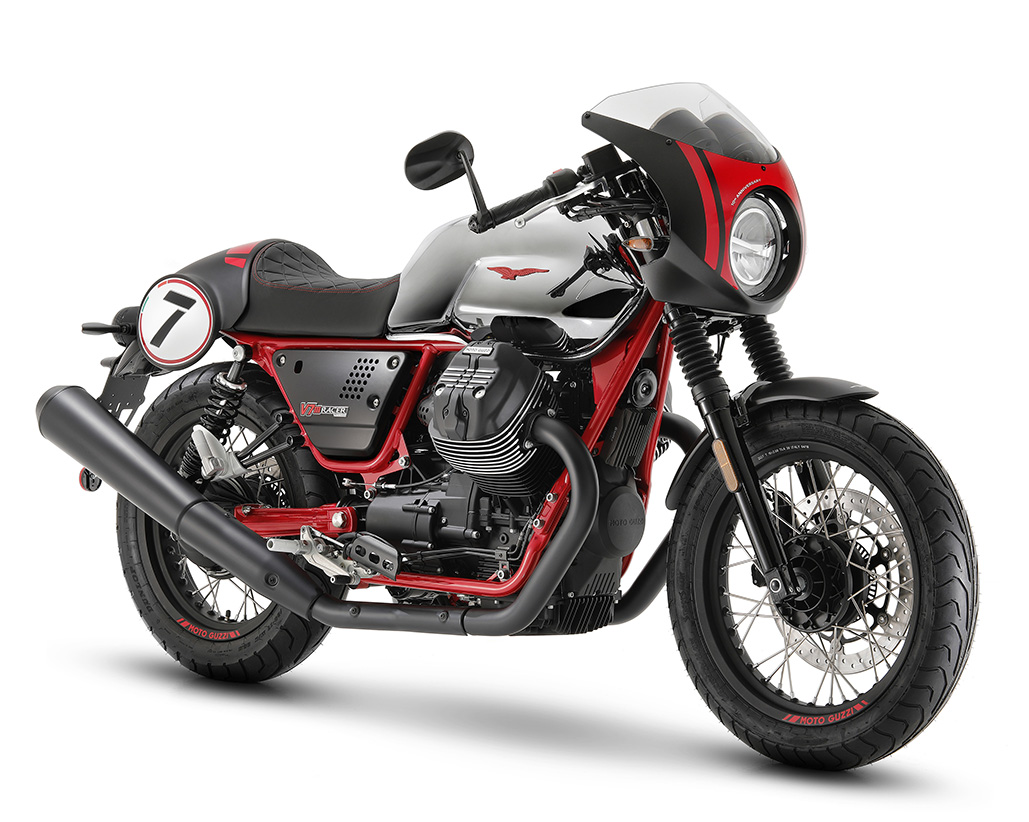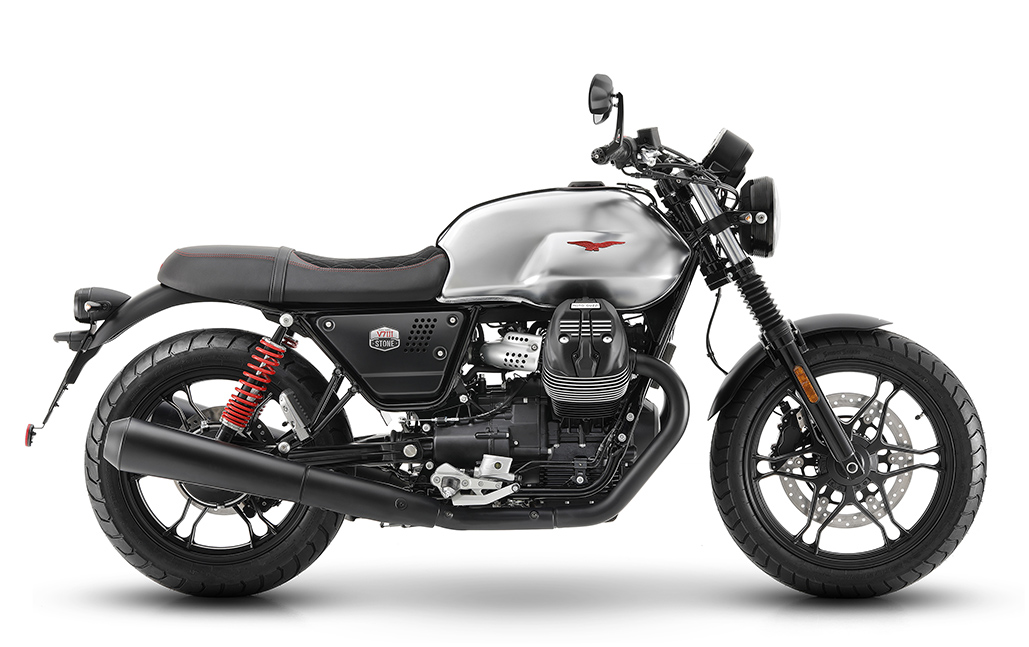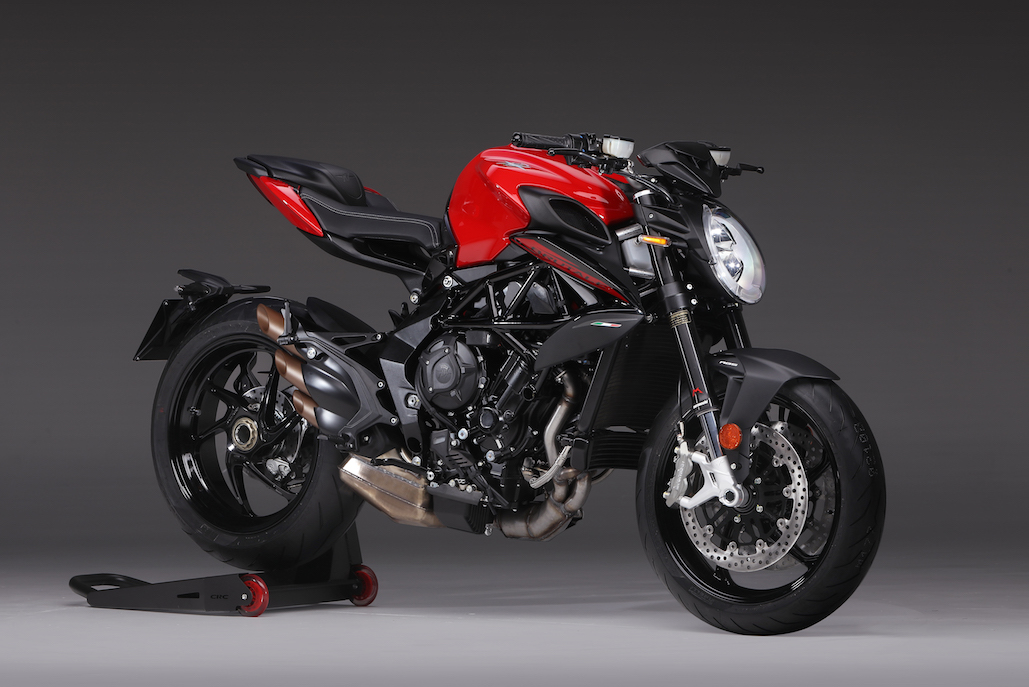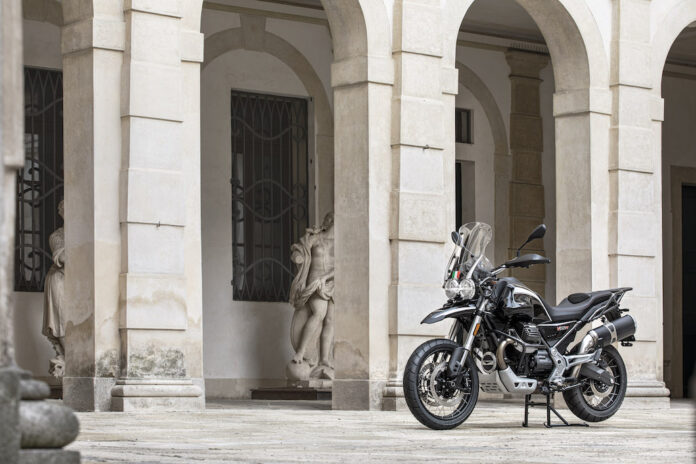Moto Guzzi V7 III
V7 is one of the most celebrated and well-known Moto Guzzi models. This global fame is due to its ability to remain faithful to the expectations and reputation of a legendary brand like Moto Guzzi. Since 1967, the year the first units were sold in Italy, the V7 has become a cornerstone of the product range, representative of the ultimate Italian motorcycle and standing out for its content and design, highly popular with a wide and varied public.
More than fifty years after the launch of the first example, Moto Guzzi V7 III is the third act of a unique story. The challenge of introducing the V7 III was one of the most difficult, considering the heraldry and success of the V7. It has also been the brand’s best-selling model since 2009, the entry level bike in the Moto Guzzi world.
As was the case with the V7 II compared to the first-born V7, the revamping of the V7 III was significant enough to merit a new Roman numeral, which have always been used in reference to the popular and long-lasting Moto Guzzi bikes. V7 III is the result of Moto Guzzi passion, the company skilfully updating its best seller while retaining its original character and authenticity, values that are set to last.
SIX VERSIONS AND INFINITE INTERPRETATIONS
In 2020, the V7 III family is updated with the introduction of two new models: the essential V7 III Stone, already available in the “Night Pack” variant with full LED light set and specific style details, is enriched with a new limited edition, the sportier looking V7 III Stone S, only 750 numbered units of which are being produced.
While the already well-known V7 III Special and V7 III Rough remain unchanged, another new entry is the V7 III Racer 10th Anniversary, created to celebrate the tenth anniversary of the first Eagle-branded Café Racer model and adopting a new top fairing and full LED light set.
The “seven-fifty” from Mandello has proved to be an excellent starting base for custom projects. The Moto Guzzi original accessories catalogue dedicated to the V7 III includes more than 80 parts and continues to grow, the V7 III therefore lending itself to an infinite variety of interpretations, allowing the rider to create their own made to measure special, just like a tailored suit.
OWNING AND RIDING A V7 IS NOW EVEN MORE PLEASURABLE
The third generation of the “seven-fifty” from Mandello will continue to be the Moto Guzzi entry-level model. Easy to ride and one of the most contained in the category in terms of its size and weight, it also flaunts a strong and authentic character, typical of all Moto Guzzi bikes, much of which is shown off by the transversal V-twin engine, a one-of-a-kind configuration. The primary goals steering this evolution had to do with style, standard equipment and performance on the road, in other words, aspects that influence the pleasure of owning and riding a V7.
V7 III retains the stylistic personality of the model, characterized by a design that communicates with shapes inspired by Moto Guzzi heritage and modern motorcycle requirements. The first impression is that you are in the presence of a mature and sturdy bike, a sensation due primarily to the presence of dual pipe exhaust manifolds and engine heads, both with generous dimensions, despite V7 III proving to be one of the most accessible and sleekest motorcycles. On the other hand, the metal fuel tank has not changed, with its excellent 21-litre capacity and style inspired, as ever, by that of the magnificent 1971 V7 Sport. Also standing out for their refined style are the injector covers and side fairings with their sleek shape. Each of the V7 III versions has a dedicated saddle with brand new graphics and coverings. V7 III Stone and Rough adopt a single circular instrument display, in line with their image as essential motorcycles. Meanwhile, the Special and Racer versions feature a second circular display for the rev counter. The speedometer has an analogue dial, while all other information is contained in the digital box: odometer, partial and daily trip (resets automatically eight hours after being switched off), trip time, instantaneous and average consumption, air temperature, average speed and the MGCT (traction control) level, as well as the engaged gear indicator, for which the minimum and maximum rpm value can be adjusted by the user. This way, you can control a predetermined engine rpm range, to run in the bike as effectively as possible or to reduce fuel consumption to a minimum for example. The rider interacts with the instrumentation using the button on the right-hand electrical block. The rich catalogue of dedicated accessories also includes MOTO GUZZI MIA, the Moto Guzzi multimedia platform that connects your smartphone to the vehicle, providing an exceptional quantity of information handy for your trip.
CHASSIS: A GUARANTEE OF QUALITY IN THE MOTO GUZZI TRADITION
Moto Guzzi is renowned for its ability to design exceptional chassis. The delightful ride of the V7 has its origins in the distant past: in 1970, after a highly demanding series of tests, the V7 Police won the selection to join the LAPD (Los Angeles Police Department) team, demonstrating the Larian brand’s authority on the matter even overseas. The steel frame maintains the double cradle tubular layout and the same weight distribution (46% front; 54% rear) typical of recent V7 tradition; the third generation introduces an entirely revamped and reinforced front end with different steering geometry to guarantee greater dynamic performance through the turns, as well as better handling and stability. Particular attention has been paid to the painstaking care and finish of the details, including the welding and paintwork. The rear suspension system relies on a pair of Kayaba shock absorbers, adjustable in spring preload: thanks to their superior quality and the inclination on the fixing point to the frame, they provide a progressive and controlled response in any situation, even when riding two-up. The passenger can count on a comfortable seating position, thanks to the low and forward positioning of the foot pegs. The saddle-handlebar-footpeg triangulation is ideally spaced for riders of any height thanks to the lower saddle(770 mm from the ground) and the correct positioning of the aluminium footpegs.
SMALL BLOCK ENGINE: UNIQUE CHARACTER AND SOUND
There are many excellent twin cylinder engines in the world, but there is only one transverse V and it is the Moto Guzzi twin, born in 1967 thanks to the ingenious intuition of Giulio Cesare Carcano and characterised by a unique cylinder configuration that made it an integral part of the bike’s design, like a true modern art metallic sculpture. In the small block version, it has arrived at its third evolution and has been completely revamped with respect to the unit that equipped the V7 II, with the goal of boosting riding pleasure to the max, as well as guaranteeing higher performance and reliability.
The aluminium crankcase, stiffened at its central points, adopts a crankshaft with inertia calculated so as to ensure pep and an adequate engine brake. The lubrication system in the crankcase is designed to dissipate the heat in the best possible way and reduce power absorption in favour of both performance and a reduction in fuel consumption. There is also a ventilation system that reduces power loss owing to the internal pumping of the crankcase chambers and a reduced capacity oil pump capable of absorbing less power. The oil pump intake duct is new, as is the related by-pass valve and piston cooling oil jets have been introduced that have a flow control and management valve. The alternator cover includes the blow-by gas output.
The changes introduced a year ago also concerned the high part of the engine, with entirely new cylinder heads, pistons and cylinders in aluminium with respect to the V7 II, although the bore and stroke, and therefore the engine displacement, remain the same, a choice that sees V7 III confirm its place as a Moto Guzzi entry-level motorcycle range. As per tradition, timing is controlled by a pushrod and rockers system with 2 valves per cylinder, but arranged in an inclined position (more efficient) in the head. The fuel system is entrusted to a single-body Marelli electronic injection system managed by an electronic control unit. The exhaust system is complete with dual pipe manifolds that help to improve thermal insulation. With the auxiliary air system intake in the heads, combined with the trivalent catalytic converter, the double lambda probe and the engine design, the Moto Guzzi twin 750 complies with the Euro 4 standard.
Power reaches a maximum of 52 hp at 6200 rpm, while maximum torque comes in at 60 Nm at 4900 rpm, with a truly flat torque curve that promise ease of use combined, as ever, with that typical character and rapid response of a Moto Guzzi engine. A reduced-power version is also available, in line with the limitations set by the A2 class driver’s license and ideal for new Guzzi riders, who can also count on a contained total weight and size and the general ease of riding ensured by all V7 III versions. Another innovative aspect of the Moto Guzzi engine is the 170 mm dry single disc clutch that increases sturdiness and reliability over time, also decreasing the load on the lever at the handlebar, all to the advantage of modulability and riding comfort. The six speed gearbox, precise and smooth in shifting, remains unchanged compared to the V7 II, but it benefits from a different ratio for first and sixth gear, both slightly lengthened, handy for taking better advantage of the engine’s torque and power features.
SAFETY: A MOTO GUZZI ASSET
Moto Guzzi has always been at the top of its game when it comes to safety aspects. V7 III has an ABS braking system and an adjustable MGCT (Moto Guzzi Traction Control) system that can also be disabled. The former is a two-channel Continental system that prevents the wheels from locking up, whereas the latter is a system that prevents rear wheel spin in acceleration. The MGCT system is adjustable to two sensitivity levels, one more conservative and ideal, for example, in poor grip situations due to wet or slippery asphalt and the other is designed to cater to the thrill of riding in safety on dry roads. Another peculiarity of the MGCT system is the possibility to recalibrate rear tyre circumference, compensating for any wear or the use of a tyre with a different profile than the original so that the traction control will always be precise.

V7 III STONE
V7 III Stone stands out for its strong aesthetic and personal connotations. Eclectic and essential, it forsakes any chrome details to embrace the darkness of the matte black paintwork, added to which is a brand new matching passenger grab strap.
The total “dark matte” look is completed with a black light setting and the eagle that adorns the fuel tank, created with a particular burnished finish. Yet these are not the only differences for which V7 III Stone stands out from the other versions: the front mudguard is shortened to enhance the essential nature of this model, and painted to match the fuel tank. the wheels are spoked and the instrument cluster comprising a single circular display.
In addition to Nero Ruvido, V7 III Stone is available in two new and attractive satin finishcolour schemes, Grigio Granitico and Rosso Rovente.
V7 III Stone is also available in the Night Pack variation, characterised by significant stylistic and functional changes, the first of which is the implementation of new LED lights which ensure significant lighting power for the headlight, turn indicators and taillight.
This version, aesthetically defined by the low positioning of the headlight and instrument cluster, boasts a new rear mudguard, short and sleek, into which the brake light bracket and license plate holder are integrated.
The dedicated saddle is characterised by heat welding and enhanced with the embroidered Moto Guzzi logo. V7 III Stone Night Pack is available with the classic Nero Ruvido livery or in the Bronzo Levigato and Blu Pungente variations.

V7 III STONE S
The only member of the 2020 V7 III family to be produced in a limited edition, Moto GuzziV7 III Stone S will be manufactured in just 750 units, a number that evokes the engine capacity of the “seven-fifty” from Mandello. To further highlight the exclusive nature of this particular version, the serial number of the model is engraved on the handlebar riser.
The distinctive elements that make the new Moto Guzzi V7 III Stone S immediately recognisable are the beautiful satin chrome fuel tank, wrapped on the top by a black leather strap, and the full LED light clusters, including the headlight, taillight and turn indicators: a modern, high-tech spirit, seen for the first time on the “Night Pack” variation of the V7 III Stone, which also includes the lowered position of the headlight and instrument cluster and ashorter and sleeker rear mudguard. All of this, along with brand new “bar end” rear view mirrors, give the Stone S an even more slender and dynamic profile.
Another sporty touch comes in the form of numerous red details: the ever-present Eagle on both sides of the fuel tank, the shock absorber springs and the elegant red stitching that enhances the special dedicated saddle, upholstered in water-repellent Alcantara®, an entirely weather resistant material. The equipment package also includes an anodized black locking fuel cap made from aluminium billet and the side panels, also in aluminium with a dedicated logo.
The mechanical part is also elegantly dressed, with the throttle body covers in natural anodized aluminium and the cylinder heads with milled cooling fins.
Also new on the Moto Guzzi V7 III Stone S are the high-performance Dunlop Arrowmax Streetsmart tyres, emphasising the dynamic qualities of the Eagle brand’s “seven-fifty” in its most recent and brand-new sporty interpretation.
V7 III SPECIAL
Of the V7 models, this is the one that comes closest to the spirit of the original model. Classic and elegant, it features numerous chrome parts and decidedly bright graphics. Like the famous 1975 V750 S3, it has the typical coloured stripe on the side fairings under the saddle that complements the matching horizontal band on the tank. The spoked wheels have polished channels and black hubs; the instrumentation is made up of dual circular displays and the chromium plated steel passenger grab handle comes standard. V7 III Special also has a saddle with “old school” stitching, elements that highlight its classic and elegant roots. It is available in the Nero Onice and Grigio Cristallo colour variants.
V7 III ROUGH
This version stands out for its knobby tyres mounted on spoked wheel rims and the many details that give the V7 III Rough its urban/country look. The equipment is completed with the dedicated saddle with stitching, passenger grab strap and the pair of aluminium side fairings. The mudguards are made of the same high-quality material. The headlight frame is painted black and the fork stanchions are protected by classic rubber dust covers. Another Moto Guzzi style proposal that sees the V7 III transform into a true factory special thanks to just a few skilful touches. V7 III Rough is available in the Grigio Grafite and Verde Mimetico colours.

V7 III RACER 10TH ANNIVERSARY
Moto Guzzi V7 Racer has always been the ambassador of the V7 range, the model with the sportiest spirit of all. Born in 2010 and developed in 2015 with the arrival of the V7 II Racer and in 2017 with the birth of the third generation, in 2020, the Moto Guzzi V7 III Racer reinvents its self once again, and does so in accordance with tradition of course, celebrating the tenth anniversary of the first model’s birth.
The new Moto Guzzi V7 III Racer 10th Anniversarydiffers significantly from the previous version in terms of its front view, where a new top fairing with incorporated windshield stands out, sleek and sporty, in line with the traits of authentic Café Racer style. The top fairing is enhanced with dedicated red graphics – also picked up on the saddle cover hump – which flaunt the “10th Anniversary” celebratory detail.
At the centre of the top fairing is the new, full LED headlight, just as the taillight and turn indicators are also LED. A modern and dynamic look also emphasised by a thinner and sleeker rear mudguard, and by brand new “bar end” rear view mirrors.
Numerous style features hark back to previous versions of the Café Racer from Mandello, all tributes to its ten-year heritage: the fuel tank, wrapped on top with the classic leather belt, does away with satin look chrome to return to the beautiful glossy chrome that characterised the original 2010 model, while other distinctive V7 Racer and V7 II Racer traits reappear on the racing number plates, namely the number 7 and red edging with Italian flag detail.
As for the rest, Moto Guzzi V7 III Racer 10th Anniversary retains the fundamental characteristics of a model that has become iconic, such as the frame and the swingarm painted in “Rosso Corsa” (racing red), an explicit reference to the 1971 V7 Sport, nicknamed, in fact, “telaio rosso” (red frame); the semi-handlebars, the splendid, humped saddle, now enhanced with red stitching, that has a single-seat look but is approved for two-up riding as well: in fact, it has pillion foot pegs, whereas the seat cover can be easily removed when necessary. The spoked wheel rims have black channels and red Moto Guzzi stickers like the other sport models from the Eagle Brand, including the Audace muscle bike.
Produced as always in anumbered edition, as indicated by the plate located on the upper steering yoke, V7 III Racer 10th Anniversary is not only the sportiest in the range, but also the model with the most prestigious parts, once again demonstrating Moto Guzzi’s ability to create true custom models. These include the rear-set machined from solid adjustable footpegs, the lightened steering stem and the steering yoke guard. Another feature worth mentioning is the extensive use of black anodized aluminium. This artisan treatment, which requires superb craftsmanship, characterises the side fairings and the throttle body guards.
The V7 III Racer 10th Anniversary, like the new Moto Guzzi V7 III Stone S, is also shod with new Dunlop Arrowmax Streetsmart tyres, higher performance, so you can fully enjoy the dynamic qualities of the Café Racer from Mandello.
MOTO GUZZI MIA CONNECTS V7 III TO THE WORLD
For the V7 III range, the innovative MOTO GUZZI MIA multimedia system is available as an optional accessory. This system is able to connect the bike to a smartphone. Thanks to a dedicated application, which can be freely downloaded from the App Store and Google Play, the smartphone (iPhone or Android) becomes a truly sophisticated on-board multifunctional computer, the link between the vehicle and the Internet.
The Bluetooth connection allows you to simultaneously view five parameters of your choice at a time, selected from a vast menu and including the speedometer, rev counter, instant power, instant torque, instant and average fuel consumption, average speed and battery voltage, longitudinal acceleration and extended trip computer. The “Eco Ride” feature helps to limit fuel consumption and to maintain eco-compatible riding conduct, providing a brief assessment of the results obtained during the trip. You can record trip information and review it on your computer or directly on your smartphone, analysing the route taken, viewing the vehicle operating parameters point by point. The system also allows you to easily locate your vehicle when you park in a strange place, automatically saving the position where it was switched off. MOTO GUZZI MIA includes the “Grip Warning” function that replicates the indications on traction control operation for maximum visibility, and alerts you in the event of excessive use of available traction. Thanks to the synergistic use of gyroscopes and the information coming from the direct connection with the vehicle electronics, the smartphone becomes a sophisticated instrument to measure the lean angle in turns.
ORIGINAL MOTO GUZZI ACCESSORIES: A WIDER AND WIDER RANGE
After the success achieved on V7 and V7 II, the Moto Guzzi Garage customization philosophy continues on the V7 III as well. This means that there are countless accessories available so that you can personalize your motorcycle in a fun and safe way, creating a true made to measure special.All of the parts have been conceived, designed and made by Moto Guzzi and they are subjected to strict control test cycles just like any other original part on the bike in order to guarantee a quality and long-lasting product. Since they have been conceived and fine tuned by Moto Guzzi they are perfectly interchangeable with the factory parts, allowing you to easily revert your bike to its original configuration. They are also fully approved and therefore absolutely “street legal”.
The following are a few of the main accessories in the catalogue dedicated to the V7 III range which includes a total of more than 80 items.
Arrow 2 in 1 high exhaust: the 2 in 1 exhaust developed in collaboration with Arrow lightens up the design of V7 III, giving it an even sportier look.
Öhlins shock absorbers: adjustable in spring preload and in hydraulic rebound and compression, Öhlins shock absorbers ensure better capacity to absorb small bumps and at the same time provide better control in fast riding.
Red shock absorber springs: designed specifically to be fitted on the V7 III standard shock absorbers.
Red front brake calliper: the Brembo front brake calliper painted red gives the vehicle a more aggressive look.
Red cylinder head covers: the red painted cylinder head covers with special machining customise the unmistakeable Moto Guzzi twin 750.
Aluminium side panels: the aluminium side panels contribute to making the profiles of the V7 III sleeker and more precious, thanks to the materials and the machining. Available in satin finish or black aluminium.
Carbon side panels: the side panels in carbon fibre enhance and lighten the central part of the V7 III with premium materials and finishes.
Aluminium mudguards: made in lightweight aluminium, the front and rear mudguards are available in total black look or polished aluminium.
Carbon mudguards: the front and rear mudguards in carbon fibre enhance the youthful and dynamic character of the V7 III.
Tubular engine guard: characterised by a design that follows the lines of the vehicle, combining style and functionality, the engine guard provides specific protection for the engine and the rider’s legs. Available in chromium or black.
Fuel tank cover: these are two soft rubbery guards that are applied to the sides of the fuel tank where the rider’s knees rest in order to increase riding comfort.
Aluminium top fairing: the front number plate in satin finish or black painted aluminium gives the V7 III a strong and decisive style.
Windshield: this is designed to provide greater aerodynamic protection without compromising the attractive aesthetics of the V7 III. Type-approved for the strictest standards (DOT and TUV), it has been road tested in all weather conditions by Moto Guzzi test riders.
Injector covers: made of anodised aluminium, these protect the injector area from accidental contact with the rider’s knees. Also available painted black.
Aluminium brake and clutch levers: made of billet aluminium and with a unique and popular design, they enhance the controls of the V7 III with prestigious materials and exclusive style.
Side panniers in leather, canvas and touring: thanks to the frames featuring fast click quick release, you can use various types of side panniers on the V7 III. The Moto Guzzi range of accessories includes a pair of panniers in precious, hand crafted leather with closing and buckles in steel and hot-branded with the Moto Guzzi logo, a pair of Touring panniers in sturdy technical fabric to withstand any travel conditions and a pair of very spacious and elegant waterproof Canvas panniers. A special anti-theft locking system prevents any undesired fast click quick release.
Luggage carrier: this valuable item serves two important purposes: on one hand it is a luggage rack and on the other it provides a solid hold thanks to the two built-in handles. Painted black, it mounts in place of the original passenger grab handles.
Top box bag: attaches to special luggage rack and made in waterproof genuine leather. It can be easily transported thanks to the rear handle.
Tank cover band: fuel tank cover band in waterproof genuine leather. This adds a strong “garage” characterisation to the V7 III fuel tank and allows a possible leather tool pouch to be connected.
Saddles range: the range of Moto Guzzi saddles for the V7 III includes more than 10 versions and variations to meet any and all comfort and design needs. All the saddles are fully waterproof, made in premium materials that provide maximum comfort and a unique aesthetic impact that perfectly matches the bike’s look.
Motorcycle cover: : this cover is made from black scratch proof material and is made precious by the Moto Guzzi logo on both sides, and also in the “Eagle” and “Shape” versions.
THE ORIGINS OF THE LEGENDARY V7
The year was 1961 and the success of the mass produced car was radically reorganizing the motorcycle market. Moto Guzzi, empowered with enviable design capacity reacted to the unfavourable circumstances by exploring new markets, from delivery three-wheelers to agricultural machinery and special vehicles – even cars. For the latter, the genius designer Giulio Cesare Carcano designed a 90° V-twin air cooled engine destined for a sport version of the Fiat 500, capable of touching 140 km/h. They liked the new engine in Lingotto, but the annual quantity that Vittorio Valletta requested exceeded the production capacity of the Mandello del Lario plant, so the agreement never came to fruition.
Mr. Carcano, however, did not lose heart and he increased the size of the two cylinder engine to 754 cc to use it on the “3X3”, a popular, variable track three wheel drive vehicle destined for use by Alpine troops. At the same time a ministerial tender was launched to provide motorcycles for the Highway Police the winner would be whoever could travel 100,000 km with the lowest maintenance cost. It was the perfect chance to place Mr. Carcano’s two-cylinder, entirely revamped, on a bike, the Moto Guzzi V7. It was an innovative project that combined the reliability of automotive standards with a level of comfort and mechanical affordability unknown to the competition that aroused the curiosity even of foreign police forces, Los Angeles being among the first. Testing of the new V7 700 began in 1964. The bike had a 703.3 cc engine for power of 40 HP and a weight of 230 kg. Standard production got underway in 1966, the vehicles destined for the police and overseas markets while the following year saw the V7 700 distributed in Italy at the competitive price of 725,000 lire, decidedly chapter than its German and British competition.
EVOLUTION ACCORDING TO LINO TONTI
Giulio Cesare Carcano’s creation was perfected by an expert designer who joined Moto Guzzi in 1967: Lino Tonti. Hailing from Forlì, with a great deal of experience in competitions with Mondial, Bianchi and Gilera, the engineer was called on by the general manager Romolo Stefani to expand the range of the maxi-bike from Mandello del Lario. The V7 appeared at the right time, bikes were coming domineeringly back into fashion almost as a reaction to the conformism of the car and the market is particularly open to innovations.
The first thing Tonti did was to increase the engine size to 757 and the power to 45 HP to launch the V7 special in 1969, faster, more refined and more elegant than the V7 700. Then he created, initially for the American market, the V7 Ambassador and the California, the latter destined to be one of the greatest Moto Guzzi success stories. The next milestone coincided with Lino Tonti’s masterpiece: the V7 Sport. The designer from Forlì had clear ideas and he set the three parameters of the sport bike from Mandello: 200 km/h, 200 kg, 5 gears. To achieve the objective he made some changes to the engine, taking the displacement to 748.3 cc and the power to more than 52 HP, redesigning the crankshaft and camshafts, in addition to placing the alternator in the front in order to keep the vertical bulk down.
The engine was lodged in a tight, double cradle frame in chrome molybdenum steel, painted red for the first 200 units and assembled directly in the experience department on via Parodi, No. 57. The bike made its début in 1971 and in June of the same year it participated in the “500 kilometres of Monza” race taking third place with Raimondo Riva. This was the beginning of a series of flattering results obtained in endurance races such as the 24 Hour Le Mans and Liegi races which would contribute, together with very popular riders such as Vittorio Brambilla, to making it the most famous Italian sport bike of the 1970s.
FROM THE V7 TO THE 850 GENERATION
Over a couple of seasons the technological evolution which was achieved with the V7 Sport Moto Guzzi was also transferred to the rest of the range. The new frame, the four pad front brake and the five speed transmission introduced on the V7 Sport represented, together with the increased engine size, the primary innovations of the V850 GT, a model which would mark the retirement of the lucky V7 Special in 1973. The Sport would also lose the famous alphanumeric name, replaced in 1974 by the Moto Guzzi 750S. The last model to give up the glorious alphanumeric name was the V7 850 California, which would not pass the baton to the new 850 T California until 1976.















